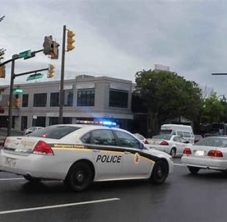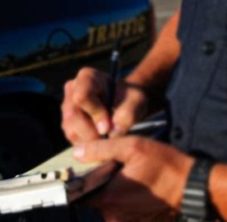I had the good fortune to discuss street safety with a national expert on the matter, Professor Eric Guerra from the University of Pennsylvania. He co-authored a recent study “Do Denser Neighborhoods Have Safer Streets? Population Density and Traffic Safety in the Philadelphia Region.” Professor Guerra is currently the director of the Cooperative Mobility for Competitive Megaregions (CM2), a research group heavily involved in understanding what contributes to causalities on the nation’s streets as well as what contributes to improved street safety.
Based on the research you recently co-authored, is it true that unconditionally and without exception a denser neighborhood has safer streets?
No, nothing is ever true unconditionally. Moreover, when it comes to safety research, population density doesn’t necessarily mean a lot of people in a small place. In safety research, population density is often a proxy for exposure to accidents, and exposure is one characteristic contributing to street safety. The other characteristic is risk or severity. Just because a lot of people are exposed doesn’t mean accidents happen, and just because there is a high-risk situation doesn’t mean accidents are fatal. Both those characteristics together combine to make high-fatality situations.
Population density can also be an indication of the physical environment. Dense neighborhoods tend to have narrower streets (not always) and slower traffic (not always).
In spite of all those qualifications, if you look across many areas throughout the United States, denser areas tend to be substantially safer. Nationwide, US fatality rates tend to be 10–12 per 100,000 residents. If you look at Boston, DC, and New York, the fatality rate is in the range 3–5 per 100,000, compared to cities in Texas that run about 12 fatalities or higher per 100,000. As a general rule, denser areas tend to have better traffic safety outcomes.
Do you have an example of a densely populated area that is relatively unsafe?
One example is when a busy street runs through a dense neighborhood. I frequently study Roosevelt Boulevard in Philadelphia. It goes through some very densely populated neighborhoods, and has a difficult safety record.
That being said, a major artery in a dense area doesn’t guarantee carnage. In many cases, when a busy street is in a dense neighborhood, there are a significant number of pedestrians, they are visible, the drivers are aware of their presence, so the drivers reduce their speeds and are more cautious. A few miles away the same street may be in a sparsely populated area where there are fewer pedestrians. In those situations drivers tend to be less aware, less cautious, and their speeds may naturally increase.
You mentioned that nationwide there are about 10–12 fatalities per 100,000 residents. Is fatalities per capita the best measure of street safety?
There is an honest debate about how to report traffic safety. Most government agencies prefer to report fatalities per vehicle-miles traveled (VMT), whereas researchers and institutions such as the World Health Organization prefer to use fatalities per capita. Compared to other nations, the US ranks better on the VMT metric than it does per capita.
What is it about denser neighborhoods that make their streets safer?
Denser neighborhoods are characterized by three behaviors: fewer people driving, those who do drive tend to drive shorter distances, and they tend to drive at slower speeds.
It seems intuitive that in dense areas people drive slower and for shorter distances, but why are there fewer people driving?
Because in those areas there are typically fewer vehicles per capita, and that contributes to fewer collisions per capita.
Do you have a sense that installing more speed-limit signs at shorter intervals helps to bring down prevailing speeds?
Potentially. In Philadelphia certainly not, while in Athens, Georgia, probably yes. Obeying posted signs boils down to a culture of respecting the rules and regulations. In some places that culture is more entrenched than in others, so as a result installing signs may or may not have an effect.
This brings us to the three Es of traffic safety: Engineering, Enforcement, and Education. Obeying posted signs falls under education. A policy maker must determine if drivers are speeding only because they do not know what the speed limit is in a particular location. In that case, posting a sign will have a positive effect and bring speeds down, and no more remediation is required. However, if drivers are aware that the speed limit is 25 in a given area and they speed anyway, then posting signs won’t have an effect.
For those situations in which education is not the contributing factor, enforcement is the next approach, such as issuing citations when drivers are exceeding the speed limit by five miles per hour. If enforcement doesn’t work at a particular locus, then the most decisive approach is to apply the final E—engineering. One engineering approach is to redesign the road so that it “feels” like a 25 mph street.
Speaking about engineering, Montgomery County has started implementing road diets in which one lane in one or both directions is removed from the traffic flow. Is there evidence that this policy contributes to improved traffic safety?
The purpose of road diets is to reduce speed, and frequently they succeed in doing so. Other goals include giving buses a dedicated lane (thereby reducing travel times) and encouraging bicycling.
Road diets also reduce the number of lanes pedestrians need to traverse in order to walk from side of the street to another. If an artery has three lanes in each direction, and the county removes one lane on each side, pedestrians need to cross only four lanes of traffic whereas before the diet they needed to cross six.
Lastly, removing a lane of traffic does not significantly reduce capacity.
Our county has been installing speed cameras since about the year 2007. One of our other bloggers found that during all that time there has been no significant decline in the fatality rate. Does that mean speed cameras are a failure?
The record for speed cameras is pretty solid: they do reduce crashes and fatalities. The outcome you are seeing, no measurable decrease in the fatality rate, could be because the accidents were, and continue to be, in places where the cameras are not installed.
The other consideration is counterfactual. For example, fatalities may actually increase after installing the speed cameras, but they would have increased even more without them. To make that kind of comparison you want to compare data between similar places that have speed cameras and those that don’t. That is a better comparison than the “before and after” data points at a single intersection.
For example, I’ve looked at the record on speed cameras on Philadelphia’s Roosevelt Boulevard. They were installed in 2021 shortly after COVID. Throughout Philadelphia traffic fatalities tripled that summer, but they stayed flat on Roosevelt Boulevard. That’s an indication that the traffic cameras indeed contributed to street safety.
We have some crosswalks with flashing amber lights at street level. A pedestrian can push a button, and the amber lights activate. On a busy street that sounds to me like a dicey safety proposition.
Like the posted 25 mph signs we discussed before, those indicators are effective only to the degree that drivers respect the rules. It’s all about people’s knowledge and behavior.
Those flashing signals do two things. First, they signal to an approaching driver that a pedestrian is trying to cross. Second, they engender a behavioral response. In some unfortunate instances, the driver may increase speed to pass the sidewalk before the pedestrian walks in the line of travel. If the drivers do not respect those flashing lights or outright ignore them, then the lights contribute nothing toward safety.
Nevertheless, street signals and markings do have a generally positive influence on drivers’ behavior. Legally, any intersection is a crosswalk, and you are equally liable if you strike a pedestrian at a corner whether or not a crosswalk is painted on the street. Nevertheless, when drivers physically see a crosswalk, they tend to adopt a certain behavior that they may not do at an unmarked crosswalk.
We’ve been talking about drivers and their behavior. What about pedestrians and their behavior?
You may be surprised to learn that when it comes to multi-mode collisions, such as vehicles and pedestrians, it’s about 50-50 regarding who is at fault. People on both sides are breaking the rules with equal frequency.
You mentioned the three Es and how we apply them to drivers. Can we apply the three Es to pedestrians?
Absolutely. Regarding engineering, there are streets explicitly designed to keep pedestrians out. There are arterials designed to make it difficult for pedestrians to cross. Another tactic is to build a pedestrian bridge over an arterial, but those aren’t super popular in the US.
Some countries address the conflict between vehicles and pedestrians by introducing dedicated pedestrian or cycling paths. In some towns in the Netherlands the slower mode has absolute right-of-way, so if a vehicle strikes a pedestrian, the driver is automatically at fault. The intent is to encourage the operator of the faster mode to be extra careful.
If you were the undisputed, inviolate, and supreme ruler of a jurisdiction, and you could implement two or three measures to increase street safety, what would you do?
One of the first things I would do is deploy automated enforcement. Traditional enforcement has become weak in certain parts of the country for a variety of reasons. Automated enforcement isn’t as dependent on staffing, and it serves as a revenue stream that should be dedicated to engineering—redesigning streets or infrastructure to make them safer. In a city setting, I’d foster public transportation and walking. The more people are walking or taking public transportation and the less they are driving, the safer your city is.
Beyond that, there is no uniform measure that addresses all situations. The reasons for fatalities on a rural two-lane street are different from other places.
Has being a road-safety researcher made you a safer driver and pedestrian?
Driver for sure. I’m a lot more cautious about speed on city streets in particular.




